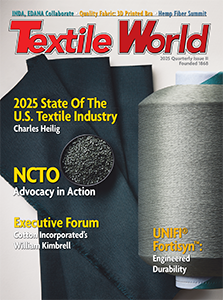In the International Year of Natural Fibres, declared by the Food and Agriculture Organization of
the United Nations, cotton is even more the focus of attention than in the past. For decades,
cotton was considered to be a kind of “bad” fiber, using too much water for irrigation, and,
moreover, too much pesticide. Those times are gone.
What Is Clean Cotton?
As Textile World has reported before, there is a totally new approach to cotton these days.
Sustainability is one of the key words. Customers around the world are putting more attention on
“clean cotton.” But what exactly is clean or sustainable cotton? As quoted in the last cotton
report from Bremen Cotton Exchange, sustainability as well as sustainable cotton production are
much-discussed terms.
However, there are still misunderstandings between sustainability and terms like “organic” or
“bio.” Back in 1987, the United Nations presented its definition of sustainability: “Sustainable
development is development that meets the needs of the present without compromising the ability of
future generations to meet their own needs.” Therefore, a sustainable agricultural production
should have an ecological, economical and social balance that also considers the options of future
developments.”
Research Programs
Under the theme “Sustainable Cotton Production,” the International Cotton Advisory Committee
(ICAC) organized a Research Associates Program, which took place April 6-16. Cotton researchers
from Ivory Coast, Germany, Greece, Sudan, Turkey and Zambia participated. The focus of the program
was to learn the definition of sustainability in combination with practical input of the cotton
production sector.
Besides modules at the ICAC office in Washington, other important locations for the US cotton
industry – including visits to the United States Department of Agriculture and Cotton Council
International in Washington, and Cotton Incorporated in Cary, N.C. – completed the program.
Improved Seeds
The US agricultural sector also tries to improve its methods through intensive research, the
report says. The use of chemical inputs is being reduced further owing to the use of genetically
engineered seeds. Furthermore, the agricultural research has reached a stage of high-tech crop
management that can reduce pesticide use to a minimum. An exact diagnosis of the soil condition,
irrigation steered by satellite and, of course, specific seed breeding are factors already used in
the fields.
To Face Financial Problems
Obviously, the financial crisis hit the textile sector. This was mentioned at a panel
discussion of the ICAC Standing Committee in which the research associates could participate as
well. The meeting took place at the Fashion Institute of Technology in New York City. The main
focus of the gathering was the panel discussion on “Demand for Cotton Products in the Economic
Crisis”. On the panel were representatives of textile-based sectors like fabric research or fabric
development as well as denim development and jeans manufacturing, but also the cotton research
sector. The main idea was that – at least in the US market – quality is of core importance. The end
consumer considers cotton a high-priced quality fiber despite the fact that man-made fiber can be
more expensive.
For more information on the important subject of sustainable cotton, please visit
www.textileworld.com.
May 12, 2009




